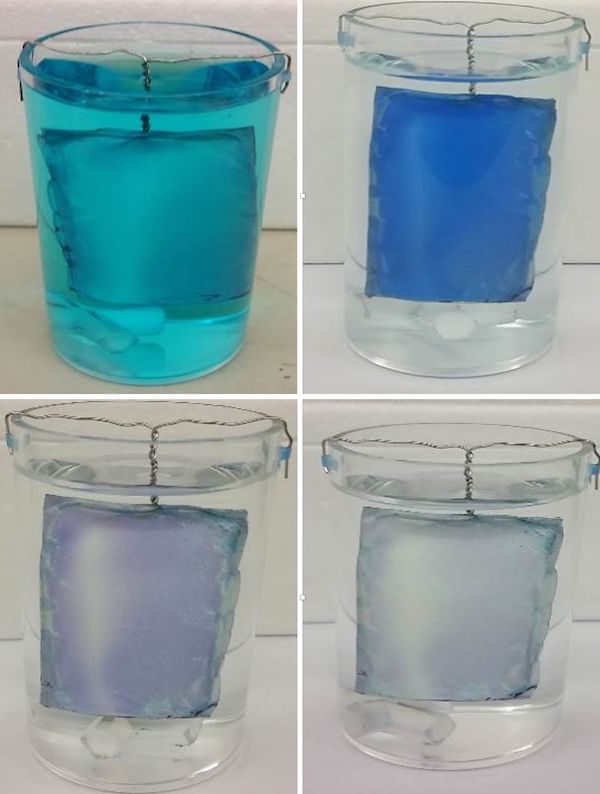Mat Baits, Hooks and Destroys Pollutants in Water
Published on by Water Network Research, Official research team of The Water Network in Technology
Rice-led NEWT Center develops energy-saving tech to remove contaminants from wastewater, drinking water.
A polymer mat developed at Rice University has the ability to fish biologically harmful contaminants from water through a strategy known as “bait, hook and destroy.”

The Rice University-led NEWT Center created a nanoparticle-infused polymer mat that both attracts and destroys pollutants in wastewater or drinking water. A mat , top left, is immersed in water with methylene blue as a contaminant. The contaminant is then absorbed at top right by the mat and, in the bottom images, destroyed by exposure to light. The mat is then ready for reuse. Courtesy of Rice University and NEWT
Tests with wastewater showed the mat can efficiently remove targeted pollutants, in this case a pair of biologically harmful endocrine disruptors, using a fraction of the energy required by other technology. The technique can also be used to treat drinking water.
The mat was developed by scientists with the Rice-led Nanotechnology-Enabled Water Treatment (NEWT) Center. The research is available online in the American Chemical Society journal Environmental Science and Technology.
The mat depends on the ability of a common material, titanium dioxide, to capture pollutants and, upon exposure to light, degrade them through oxidation into harmless byproducts.
Titanium dioxide is already used in some wastewater treatment systems. It is usually turned into a slurry, combined with wastewater and exposed to ultraviolet light to destroy contaminants. The slurry must then be filtered from the water.
The NEWT mat simplifies the process. The mat is made of spun polyvinyl fibers. The researchers made it highly porous by adding small plastic beads that were later dissolved with chemicals. The pores offer plenty of surface area for titanium oxide particles to inhabit and await their prey.
The mat’s hydrophobic (water-avoiding) fibers naturally attract hydrophobic contaminants like the endocrine disruptors used in the tests. Once bound to the mat, exposure to light activates the photocatalytic titanium dioxide, which produces reactive oxygen species (ROS) that destroy the contaminants.
Established by the National Science Foundation in 2015, NEWT is a national research center that aims to develop compact, mobile, off-grid water-treatment systems that can provide clean water to millions of people who lack it and make U.S. energy production more sustainable and cost-effective.
NEWT researchers said their mat can be cleaned and reused, scaled to any size, and its chemistry can be tuned for various pollutants.
“Current photocatalytic treatment suffers from two limitations,” said Rice environmental engineer and NEWT Center Director Pedro Alvarez. “One is inefficiency because the oxidants produced are scavenged by things that are much more abundant than the target pollutant, so they don’t destroy the pollutant.
“Second, it costs a lot of money to retain and separate slurry photocatalysts and prevent them from leaking into the treated water,” he said. “In some cases, the energy cost of filtering that slurry is more than what’s needed to power the UV lights.
“We solved both limitations by immobilizing the catalyst to make it very easy to reuse and retain,” Alvarez said. “We don’t allow it to leach out of the mat and impact the water.”
Alvarez said the porous polymer mat plays an important role because it attracts the target pollutants. “That’s the bait and hook,” he said. “Then the photocatalyst destroys the pollutant by producing hydroxyl radicals.”
“The nanoscale pores are introduced by dissolving a sacrificial polymer on the electrospun fibers,” lead author and former Rice postdoctoral researcher Chang-Gu Lee said. “The pores enhance the contaminants’ access to titanium dioxide.”
The experiments showed dramatic energy reduction compared to wastewater treatment using slurry.
Read full article: RICE University
Media
Taxonomy
- Water Pollution
- Treatment
- Treatment Methods
- Filtration
- Technology
- Filtration
- Pollution
- water treatment
- Pollution